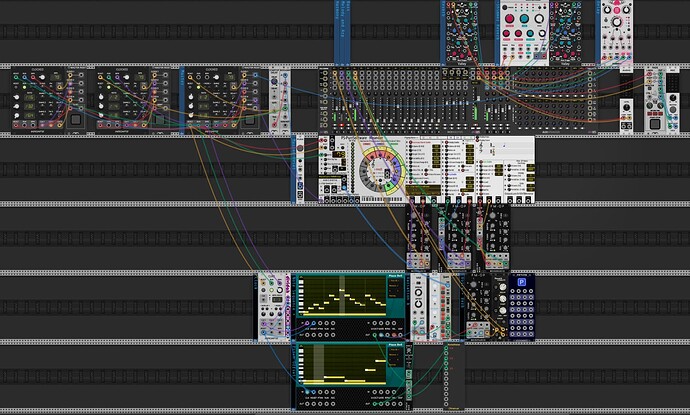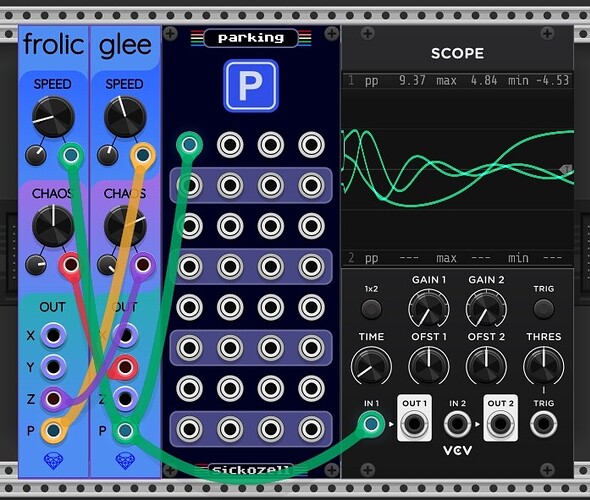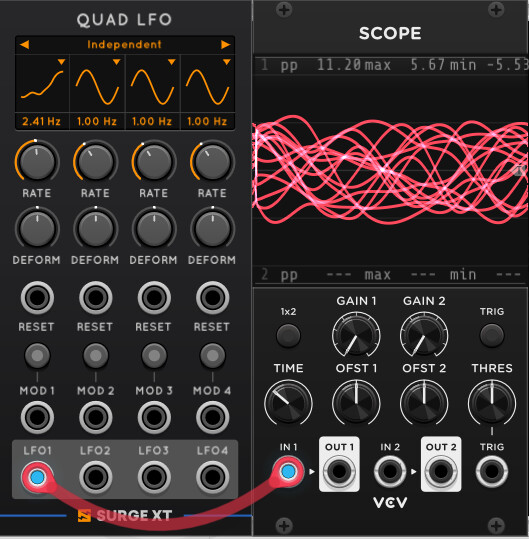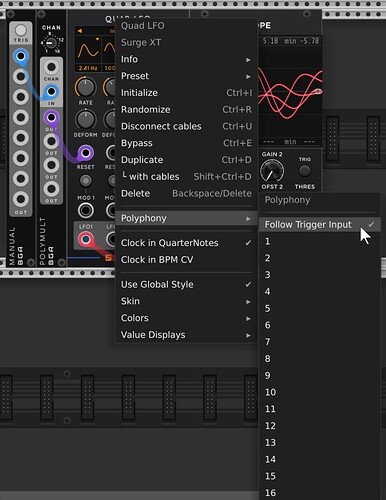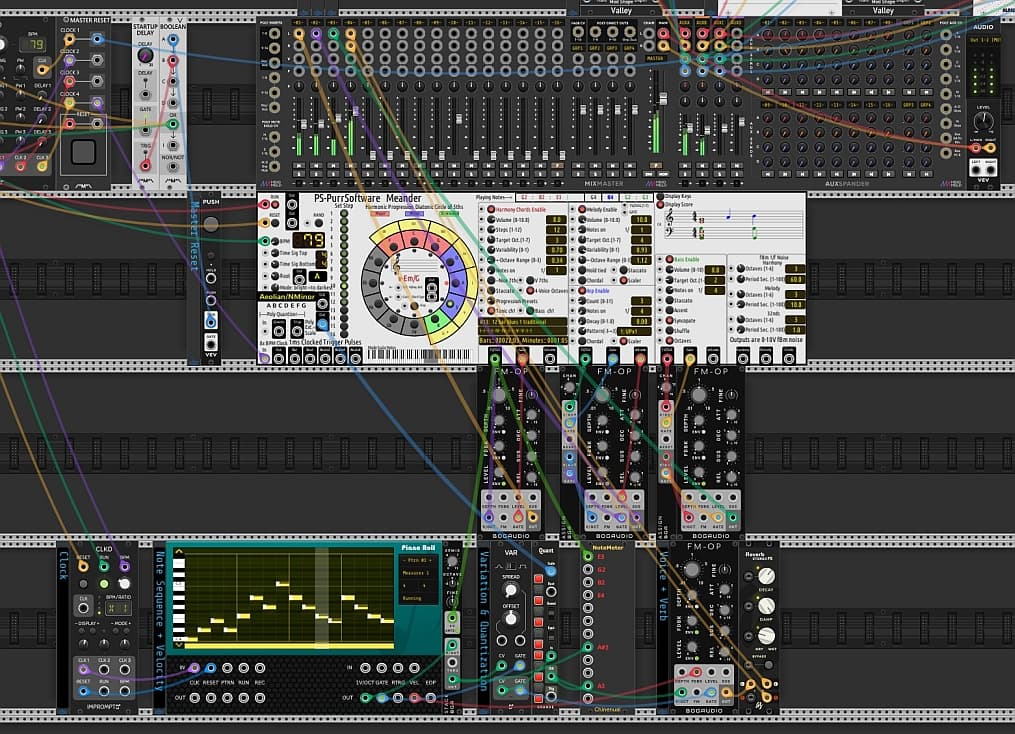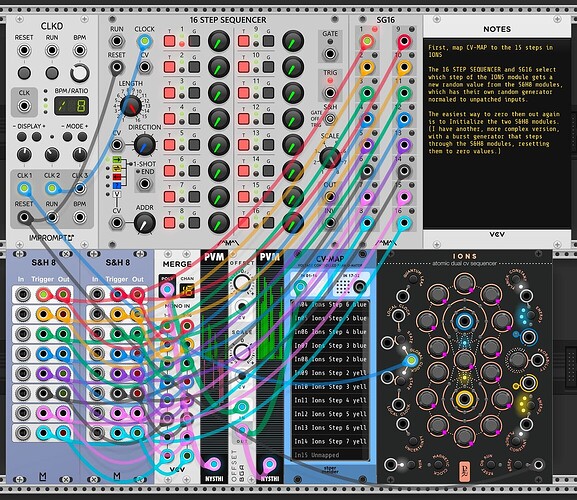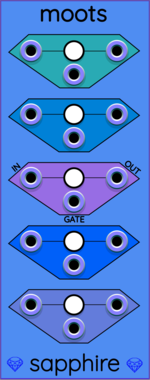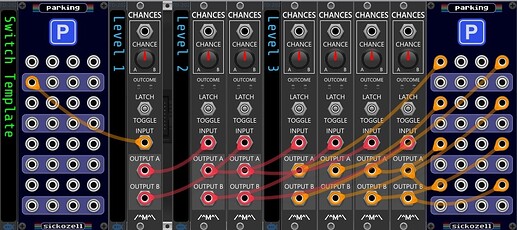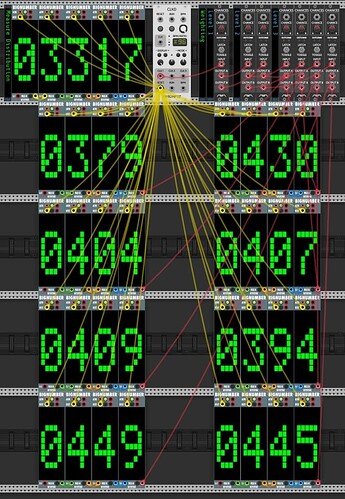These are cool. Here I have Meander conducting the piano roll sequence with both in the same mode and root via Meander’s poly external scale (PES) output and the Grande Quant quantizer which can understand PES. In this, Meander is set to a diatonic PES but can be set to a pentatonic PES scale via Meander’s right click menu.It is in Am (Aeolian A)
Polyphonic LFO
Polyphonic LFO_Alphagem-O_20240405.vcvs (4.9 KB)
As shown by @VirtualModular in a recent ambient drone tutorial. Reset button added to sync LFO phases. Set overall frequency range in LFO (Bogaudio). Set number of channels in Polycon16 (Bogaudio) and randomize its output for frequency variation.
Three irregular LFOs using Glee and Frolic, polyphonic, cross-modulation
Smooth irregular LFO w. Frolic+Glee_Alphagem-O_20240405.vcvs (3.6 KB)
Outputs an irregular smooth modulation signal with three channels in a polyphonic cable. Frolic and Glee cross-modulate each other, constantly speeding up and slowing down the speed of the output. Set speed range with Speed knobs.
Cheers @Alphagem-O ! That’s my favourite trick for getting 16 LFOs from 2 modules. Here’s another tip: try the sample and hold output (top right), I use that loads if I want a quick way of getting 16 channels of S&H (Count Modula’s Super S&H is pretty good too though). I still need to check out Frolic and Glee, so thanks for uploading that - looks like an interesting mod source.
I too cherish polyphonic modulation, as it opened a whole new world for me in terms of movement.
With Polycon16 (as with many other Bogaudio modules), I like that the output range can be set in the context menu. Choosing e.g. +/- 1V can eliminate the VCA you use in your video tutorial to curb the signal.
LLFO (Bogaudio) is great, too. It handles polyphonic signals similar to LFO (Bogaudio), but has a smaller footprint. LFO adds control over pulse width, smoothing and sampling rate in the GUI, whereas these are adjusted via the context menu in LLFO.
Thank you for the tip with the stepped random! It’s very useful when you desire an S&H-like behavior without actually pulling the trigger to sample the value(s), leading to both, amplitude and time point being randomized.
In a variant, I replaced Polycon16 with a combination of Polymult (Bogaudio) and VCV’s RND module to supply random polyphonic V/Oct to LLFO. It generates up to 16 stepped random signals in a small space.
Polyphonic stepped random
One of my favorite recent discoveries is, that the SurgeXT Quad LFO can generate random values. Up to 16 channels on each of the four outputs.
Nice find!
And with ‘Follow Trigger Input’ (see pic), the number of polyphony channels can be chosen flexibly via the number of channels fed into the Reset port.
Thank you for your patch, it seems that the Piano Roll module and Meander go along really well!
Playing with this setup some more, it showed that the arp can also be directed right from the first chord note of Meander. So, in this variant, the second Piano Roll can be left out entirely.
Piano Roll Sequence with Meander-1_Variation 01_AGO_20240413.vcv (9.4 KB)
Every time I fiddle with my IONS Incremental Randomizer it gets more compact and simpler.
Originally like this:
but now the “16 STEP SEQUENCER” and “SG16” trigger expander is replaced by Bogaudio’s “SWITCH 1-16”, with the 2nd clock also going to its input. Fifteen of the outputs are merged by VCV MERGE, and the poly output of that goes into the gate input of Bogaudio’s “S&H” (replacing the two “S&H 8” modules), so that only one of the 15 channel poly output is changed at any given step of the “SWITCH 1-16”. And I’ve added a STRIP module to preserve the mapping of CV-MAP. One of the NYSTHI “PVM” meters is no longer needed, but I added a NYSTHI “2M” meter to the blue and yellow outputs of IONS. I chose “2M” because the two meters are stacked vertically, and you can select the range of input voltages.So, (soon) it will exist as a STRIP to be loaded, rather than a proper “selection”. Or maybe it should be a selection with only the STRIP module in it because I’ll always be forgetting that it’s not actually a loadable selection.
I’ll post the updated version soon.
Ive been using a midi fighter twister, and mapping them to a patchmaster intrrface with labels, then map patchmaster params to parameters to change. You can even customize ranges in patchmaster to have a fully functioning setup. I suppose you could interface the same way with whatever midi controller. (Make a patchmaster facsimile and load in with strip++)
The premapped facsimile is a selection i use all the time.
Your post inspired me to hook up my MIDI Fighter Twister and bring it into Rack. Not sure why I had never got it working before, if I tried.
So, do you have any interesting selection files for use with the fighter that you are willing to share? Or have you already and I missed it? I have PatchMaster.
Tbh most of my patches geared towards performance are done this way.
I can send patches…
Lately ive been really inspired in studio settings where ive been helping to add synth to a couple of musician friends albums…
The workflow we use is wildly inspiring.
-
We dream up the sounds This is a collaborative process but also a speedrun tone smithing project for me
-
We agree on the terms The patchmaster acts as a simplifier of the modular environment. All understand because we build it together.
-
All hands on modulation. Long form recording of multiple people turning knobs and talking while recording.
The result is human, playful, collaborative, and long form.
Here we go, the latest “IONS Incremental Randomizer”. The first is the regular “Selection” imported via the VCV Rack File menu, the second is what you load via Stoermelder’s STRIP module.
IONS Incremental Randomizer.vcvs (16.2 KB) - I’m not sure how useful it is on its own because the CV-MAP mapping is not preserved.
IONS Incremental Randomizer.vcvss (14.4 KB)
I’ve got the SWITCH 1-16 set for random order, but the first (forward) and third (reverse) order settings can be interesting too.
Only 15 steps are in use because IONS recycles its step #1 (Blue o/p 1) as step #9 (Yellow o/p 1).
One More Thing: If I want to “de-randomize” it incrementally, I would pass any fixed voltage (say, 0 V) through a Sapphire “MOOTS” switch to the “IN” of the S&H module. With the MOOTS switch off, the S&H samples the internally-generated random voltage. With the MOOTS switch on (button or CV), it samples the fixed voltage with each tick of CLK2, and eventually all IONS steps have the same value.
The gimmick with MOOTS is that it can behave as if the output patch cord is not there at all. Very different results than applying 0V.
I am not sure what is happening, but I can load your first file via STRIP++ with preserved mappings, but the second file does not contain any modules even after renaming the extension to .vcvs.
Can you explain what for you are using the STRIP contained in the first file?
The IONS Incremental Randomizer is developing well. Your update is nice and lean, thank you for sharing it!
Moots is a lovely and useful module.
Random switch with weighted distribution
Random switch with weighting_Alphagem-O_20240418.vcvs (56.3 KB)
Random switch that allows for weighting the distribution across 8 outputs. Adjust any of the ‘Chance’ knobs to tweak distribution.
The selection contains the switch template plus a setup to test out distribution settings.
The latter can be deleted once the desired settings are found. Run by starting the clock in CLKD and watch numbers develop.
I wouldn’t think that would be possible, since the first file is a selection, intended to be loaded via File > Import selection. It should not have any preserved mappings, which is why I said it was not as useful as the second file.
I haven’t messed around with STRIP++ so I don’t know if that would make any difference in how it loads files. I would not have thought so.
… but the second file does not contain any modules even after renaming the extension to .vcvs.
I don’t quite follow that because I’m pretty sure that changing the extension would “break” it, and make it invisible to STRIP.
Can you explain what for you are using the STRIP contained in the first file?
It happened to have been selected along with the other modules when I right-clicked on them and chose “Save selection as”, which is the .vcvs file.
Really, all you need is the “IONS Incremental Randomizer.vcvss” file, somewhere (I keep it in the Selections directory, even though it’s not really a “selection”), load a STRIP module from your Library into the patch, right-click on STRIP, chose “Load” (or use Shift-L), and locate the IONS Incremental Randomizer.vcvss file. If you have subscribed to all seven plugins, it should load with the mappings preserved.
That reminds me somewhat of Aria Salvatrice’s DARIUS module which, sadly, did not get updated for the Rack v.2 library.
Thank you for clarifying!
I may be wrong, but my current understanding is that the VCV-native ‘Save selection as’ mechanism actually saves the mappings but strangely cannot recall them.
In contrast, STRIP++ can recall the mappings even though it was not used to save the selection.
There is a brief explanation for using STRIP++ that works for me.
STRIP: Ahh, now I understand that the .vcvss extension is a STRIP preset. It works after reading your explanation, thank you!
Thanks for pointing out DARIUS, I was not aware of it!
It seems to be much more capable than the simple selection I posted here. Too bad it has not been ported to v2, would have loved to play with it.
I am aware that Aria left the forum, so I think there unfortunately is not much hope that it will be available eventually.
Thanks, let’s keep this thread going! I also noticed CV-MAP doesn’t remember the mappings in selections.
Here’s a clock synchronised beat repeat/glitch thing I use sometimes, where the ADDR sequencer controls the delay time knob directly via CV-MAP. Obviously you could use the built-in attenuverters instead, but mapping the knob directly lets you go through each step and adjust the precise clock division on the delay. The wet/dry control is set to zero, and is randomly opened up via an envelope triggered from a Bernoulli gate.
A few of these strips in a patch gets fairly crazy (although obviously you’d need to reconnect everything to a single clock). Just don’t use it on the whole mix, I did that a few times and it’s a bit too much glitch ![]()
Random Beat Repeat.vcvs (13.0 KB)
